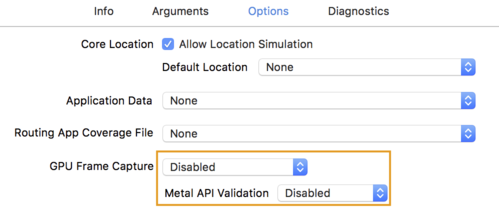使用图形处理单元 (GPU) 运行机器学习 (ML) 模型 可以显著提升模型的性能和用户体验 支持机器学习的应用。在 iOS 设备上,您可以启用 使用 GPU 加速模型执行 委托。委托充当 LiteRT,允许您在 GPU 处理器上运行模型的代码。
本页介绍如何为 LiteRT 模型启用 GPU 加速,具体代码如下: iOS 应用。如需详细了解如何使用适用于 LiteRT 的 GPU 委托, 包括最佳做法和高级方法,请参阅 GPU 委托人页面。
将 GPU 与 Interpreter API 搭配使用
LiteRT 解释器 API提供了一系列 多种用途的 API,用于构建机器学习应用。以下 相关说明指导您向 iOS 应用添加 GPU 支持。本指南 假设您已经有可以成功执行机器学习模型的 iOS 应用 。
修改 Podfile 以包含 GPU 支持
从 LiteRT 2.3.0 版本开始,不包括 GPU 代理
以缩减二进制文件的大小您可以通过指定
TensorFlowLiteSwift pod 的 subspec:
pod 'TensorFlowLiteSwift/Metal', '~> 0.0.1-nightly',
或
pod 'TensorFlowLiteSwift', '~> 0.0.1-nightly', :subspecs => ['Metal']
如果您想使用TensorFlowLiteObjCTensorFlowLiteC
Objective-C(适用于 2.4.0 及更高版本)或 C API。
初始化和使用 GPU 代理
您可以将 GPU 委托与 LiteRT 解释器搭配使用 API,其中包含多种编程方式, 语言。建议使用 Swift 和 Objective-C,但您也可以使用 C++ 和 的如果您使用的是旧版 LiteRT,则必须使用 C 高于 2.4。以下代码示例概述了如何将委托与每个 这些语言中的一种。
Swift
import TensorFlowLite // Load model ... // Initialize LiteRT interpreter with the GPU delegate. let delegate = MetalDelegate() if let interpreter = try Interpreter(modelPath: modelPath, delegates: [delegate]) { // Run inference ... }
Objective-C
// Import module when using CocoaPods with module support @import TFLTensorFlowLite; // Or import following headers manually #import "tensorflow/lite/objc/apis/TFLMetalDelegate.h" #import "tensorflow/lite/objc/apis/TFLTensorFlowLite.h" // Initialize GPU delegate TFLMetalDelegate* metalDelegate = [[TFLMetalDelegate alloc] init]; // Initialize interpreter with model path and GPU delegate TFLInterpreterOptions* options = [[TFLInterpreterOptions alloc] init]; NSError* error = nil; TFLInterpreter* interpreter = [[TFLInterpreter alloc] initWithModelPath:modelPath options:options delegates:@[ metalDelegate ] error:&error]; if (error != nil) { /* Error handling... */ } if (![interpreter allocateTensorsWithError:&error]) { /* Error handling... */ } if (error != nil) { /* Error handling... */ } // Run inference ...
C++
// Set up interpreter. auto model = FlatBufferModel::BuildFromFile(model_path); if (!model) return false; tflite::ops::builtin::BuiltinOpResolver op_resolver; std::unique_ptr<Interpreter> interpreter; InterpreterBuilder(*model, op_resolver)(&interpreter); // Prepare GPU delegate. auto* delegate = TFLGpuDelegateCreate(/*default options=*/nullptr); if (interpreter->ModifyGraphWithDelegate(delegate) != kTfLiteOk) return false; // Run inference. WriteToInputTensor(interpreter->typed_input_tensor<float>(0)); if (interpreter->Invoke() != kTfLiteOk) return false; ReadFromOutputTensor(interpreter->typed_output_tensor<float>(0)); // Clean up. TFLGpuDelegateDelete(delegate);
C(2.4.0 之前版本)
#include "tensorflow/lite/c/c_api.h" #include "tensorflow/lite/delegates/gpu/metal_delegate.h" // Initialize model TfLiteModel* model = TfLiteModelCreateFromFile(model_path); // Initialize interpreter with GPU delegate TfLiteInterpreterOptions* options = TfLiteInterpreterOptionsCreate(); TfLiteDelegate* delegate = TFLGPUDelegateCreate(nil); // default config TfLiteInterpreterOptionsAddDelegate(options, metal_delegate); TfLiteInterpreter* interpreter = TfLiteInterpreterCreate(model, options); TfLiteInterpreterOptionsDelete(options); TfLiteInterpreterAllocateTensors(interpreter); NSMutableData *input_data = [NSMutableData dataWithLength:input_size * sizeof(float)]; NSMutableData *output_data = [NSMutableData dataWithLength:output_size * sizeof(float)]; TfLiteTensor* input = TfLiteInterpreterGetInputTensor(interpreter, 0); const TfLiteTensor* output = TfLiteInterpreterGetOutputTensor(interpreter, 0); // Run inference TfLiteTensorCopyFromBuffer(input, inputData.bytes, inputData.length); TfLiteInterpreterInvoke(interpreter); TfLiteTensorCopyToBuffer(output, outputData.mutableBytes, outputData.length); // Clean up TfLiteInterpreterDelete(interpreter); TFLGpuDelegateDelete(metal_delegate); TfLiteModelDelete(model);
GPU API 语言使用说明
- 2.4.0 之前的 LiteRT 版本只能将 C API 用于 Objective-C。
- 仅当您使用 bazel 或构建 TensorFlow 时,才能使用 C++ API 自行选择。C++ API 不能与 CocoaPods 一起使用。
- 将 LiteRT 与 GPU 委托 (C++) 结合使用时,获取 GPU
通过
TFLGpuDelegateCreate()函数进行委托,然后将其传递给Interpreter::ModifyGraphWithDelegate(),而不是调用Interpreter::AllocateTensors()。
使用发布模式进行构建和测试
更改为具有适当 Metal API 加速器设置的发布 build,以 获得更好的性能并用于最终测试。本部分介绍了如何 启用发布 build 并为 Metal 加速配置设置。
如需更改为发布 build,请执行以下操作:
- 选择 Product >架构 >修改架构... 然后选择运行。
- 在信息标签页上,将构建配置更改为发布,然后
取消选中调试可执行文件。

- 点击选项标签页,然后将 GPU Frame Capture 更改为 Disabled
并将 Metal API Validation 设为已停用。

- 请务必选择“基于 64 位架构的发布版 build”。低于
项目导航器 >tflite_camera_example>项目 >您的项目名称 >
Build Settings 中依次选择 Build Active Architecture Only >发布至
是。

高级 GPU 支持
本部分介绍了适用于 iOS 的 GPU 代理的高级用法,包括 委托选项、输入和输出缓冲区,以及量化模型的使用。
适用于 iOS 的委托选项
GPU 代理的构造函数struct接受 Swift
API,
Objective-C
API,
和 C
API。
将 nullptr (C API) 或任何内容(Objective-C 和 Swift API)传递给
初始化程序会设置默认选项(请参阅“基本用法”
)。
Swift
// THIS: var options = MetalDelegate.Options() options.isPrecisionLossAllowed = false options.waitType = .passive options.isQuantizationEnabled = true let delegate = MetalDelegate(options: options) // IS THE SAME AS THIS: let delegate = MetalDelegate()
Objective-C
// THIS: TFLMetalDelegateOptions* options = [[TFLMetalDelegateOptions alloc] init]; options.precisionLossAllowed = false; options.waitType = TFLMetalDelegateThreadWaitTypePassive; options.quantizationEnabled = true; TFLMetalDelegate* delegate = [[TFLMetalDelegate alloc] initWithOptions:options]; // IS THE SAME AS THIS: TFLMetalDelegate* delegate = [[TFLMetalDelegate alloc] init];
C
// THIS: const TFLGpuDelegateOptions options = { .allow_precision_loss = false, .wait_type = TFLGpuDelegateWaitType::TFLGpuDelegateWaitTypePassive, .enable_quantization = true, }; TfLiteDelegate* delegate = TFLGpuDelegateCreate(options); // IS THE SAME AS THIS: TfLiteDelegate* delegate = TFLGpuDelegateCreate(nullptr);
使用 C++ API 的输入/输出缓冲区
在 GPU 上进行计算需要 GPU 能够使用数据。这个 通常意味着您必须执行内存复制。您应该避免将 尽可能让数据跨越 CPU/GPU 内存边界, 大量的时间。通常情况下,这样的交叉路口是不可避免的, 则可以省略其中一项。
如果网络的输入是已加载到 GPU 内存中的图片( 例如包含相机画面的 GPU 纹理)可以保留在 GPU 内存中 而无需进入 CPU 内存同样,如果网络的输出为 可渲染图片的形式,例如图片样式 转移 可以直接在屏幕上显示结果。
为了实现最佳性能,LitRT 使用户可以 直接在 TensorFlow 硬件缓冲区中读取和写入数据, 可避免的内存复制
假设图像输入位于 GPU 内存中,则必须先将其转换为
Metal 的 MTLBuffer 对象。您可以将 TfLiteTensor 与
用户准备的 MTLBuffer,其中包含 TFLGpuDelegateBindMetalBufferToTensor()
函数。请注意,在调用此函数之后必须
Interpreter::ModifyGraphWithDelegate()。此外,推理输出为
默认从 GPU 内存复制到 CPU 内存。您可以关闭此行为
调用 Interpreter::SetAllowBufferHandleOutput(true)
初始化。
C++
#include "tensorflow/lite/delegates/gpu/metal_delegate.h" #include "tensorflow/lite/delegates/gpu/metal_delegate_internal.h" // ... // Prepare GPU delegate. auto* delegate = TFLGpuDelegateCreate(nullptr); if (interpreter->ModifyGraphWithDelegate(delegate) != kTfLiteOk) return false; interpreter->SetAllowBufferHandleOutput(true); // disable default gpu->cpu copy if (!TFLGpuDelegateBindMetalBufferToTensor( delegate, interpreter->inputs()[0], user_provided_input_buffer)) { return false; } if (!TFLGpuDelegateBindMetalBufferToTensor( delegate, interpreter->outputs()[0], user_provided_output_buffer)) { return false; } // Run inference. if (interpreter->Invoke() != kTfLiteOk) return false;
关闭默认行为后,从 GPU 复制推理输出
内存到 CPU 内存需要显式调用
Interpreter::EnsureTensorDataIsReadable()。这个
方法也适用于量化模型,但仍需使用
包含 float32 数据的 float32 大小的缓冲区,因为该缓冲区绑定到
内部反量化缓冲区。
量化模型
iOS GPU 委托库默认支持量化模型。您不 需要对代码进行任何更改,才能将量化模型与 GPU 委托搭配使用。通过 以下部分介绍了如何为测试或 实验目的。
停用量化模型支持
以下代码展示了如何停用对量化模型的支持。
Swift
var options = MetalDelegate.Options() options.isQuantizationEnabled = false let delegate = MetalDelegate(options: options)
Objective-C
TFLMetalDelegateOptions* options = [[TFLMetalDelegateOptions alloc] init]; options.quantizationEnabled = false;
C
TFLGpuDelegateOptions options = TFLGpuDelegateOptionsDefault(); options.enable_quantization = false; TfLiteDelegate* delegate = TFLGpuDelegateCreate(options);
如需详细了解如何通过 GPU 加速运行量化模型,请参阅 GPU 代理概览。

